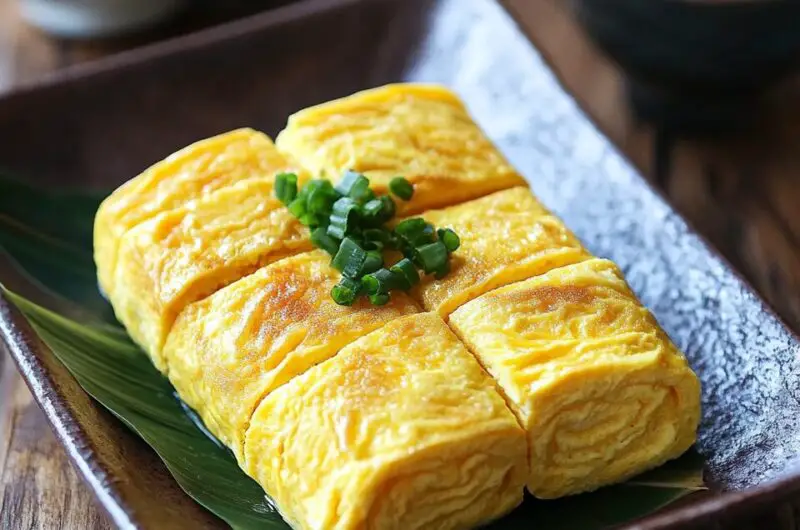Tamagoyaki (玉子焼き) is a classic and beloved dish in Japanese cuisine, often enjoyed as a comforting breakfast or a charming side dish in bento boxes. This rolled omelette is known for its delicate balance of slightly sweet and savory flavors, achieved by seasoning the egg mixture with sugar and soy sauce. Traditionally, dashi (Japanese soup stock) is added for extra depth, but this simplified recipe requires just three ingredients, making it quick and approachable for beginners or busy mornings.
Full Recipe:
Ingredients
-
3 large eggs
-
1 tablespoon sugar
-
1 tablespoon soy sauce
Directions
-
Prepare the Egg Mixture:
In a bowl, whisk the eggs, sugar, and soy sauce together until the mixture is smooth and evenly combined. -
Heat the Pan:
Heat a tamagoyaki pan (rectangular pan) or a small non-stick frying pan over medium heat. Lightly oil the surface using a paper towel or brush to prevent sticking. -
Cook the First Layer:
Pour a thin layer of the egg mixture into the pan, enough to just cover the bottom. Tilt the pan to spread it evenly. When the edges start to set but the top is still slightly runny, carefully roll the egg towards you using chopsticks or a spatula. -
Add More Egg Mixture:
Push the rolled omelette back to the far end of the pan. Lightly oil the exposed pan area again. Pour in another thin layer of egg mixture, lifting the roll gently to allow the uncooked egg to flow underneath. When this layer is almost set, roll the omelette again towards you. Repeat this process until all the egg mixture is used. -
Shape and Serve:
Remove the tamagoyaki from the pan and place it on a bamboo sushi mat or a cutting board. Let it rest for a few minutes to firm up and hold its shape. Slice into bite-sized pieces and serve warm.
Nutritional Information (Per Serving)
-
Calories: 90 kcal
-
Protein: 6 g
-
Carbohydrates: 3 g
-
Sugars: 2 g
-
Fat: 6 g
-
Saturated Fat: 2 g
-
Cholesterol: 185 mg
-
Sodium: 400 mg
-
Fiber: 0 g
Cultural Significance
In Japan, tamagoyaki is not only an everyday dish but also a symbol of comfort and care. It frequently appears in homemade bento boxes, lovingly prepared by family members for schoolchildren or workers. The neatly rolled slices serve as a visual and flavorful highlight, balancing other components such as rice, pickles, and vegetables. Its presence in bento signifies thoughtfulness and attention to detail, qualities highly valued in Japanese culture.
Tamagoyaki is also commonly served in traditional Japanese breakfasts alongside grilled fish, miso soup, and rice, setting the tone for a nourishing and balanced start to the day. Beyond home cooking, tamagoyaki is a frequent item in sushi restaurants, where it is served as nigiri or sashimi. In this context, the quality of the tamagoyaki is a testament to the chef’s skill, with subtle differences in sweetness, texture, and seasoning distinguishing one chef’s version from another.
Flavor Profile and Ingredients
The classic flavor of tamagoyaki is a delicate balance of sweet and savory, achieved by seasoning beaten eggs with sugar and soy sauce. The sugar adds a gentle sweetness that complements the rich umami of the soy sauce, creating a nuanced flavor profile that is both comforting and complex. Traditional recipes often incorporate dashi, a Japanese soup stock made from dried fish and seaweed, which adds an additional layer of depth and savory complexity. However, the simplified three-ingredient version—eggs, sugar, and soy sauce—is a fantastic starting point for home cooks and those pressed for time.
This balance of flavors makes tamagoyaki incredibly versatile. It can be enjoyed as a breakfast dish, a side to complement other savory items, or even as a snack. Because the flavors are mild and inviting, tamagoyaki also pairs well with a wide variety of Japanese dishes such as grilled fish, pickled vegetables, and rice bowls.
Texture and Technique
One of the most distinctive features of tamagoyaki is its layered, slightly spongy texture. Achieving this texture requires a precise cooking method that involves pouring the egg mixture in thin layers and rolling each one as it cooks. This process is repeated several times until all the egg mixture is transformed into a thick, multi-layered roll.
The rolling technique requires some finesse. Using chopsticks or a spatula, the cook must gently lift and fold the egg layers without breaking them, allowing uncooked egg to flow underneath for the next layer. This repeated rolling and cooking result in the signature look and feel of tamagoyaki—a firm yet tender and moist omelette with visible, delicate layers.
The cooking temperature is crucial. Medium heat allows the eggs to set gently without burning or drying out, preserving the omelette’s soft texture. The pan also needs to be well-oiled to prevent sticking, ensuring smooth rolling and an even, golden surface.
Variations and Serving Ideas
While the basic tamagoyaki recipe is simple, many variations exist to suit different tastes and occasions. Some cooks add mirin, a sweet rice wine, for extra sweetness and shine. Others may incorporate finely chopped scallions, grated daikon radish, or even nori (seaweed) inside the layers for added texture and flavor.
Tamagoyaki is traditionally served sliced into bite-sized pieces, making it easy to eat and perfect for bento boxes. It’s often enjoyed warm, but it can also be served at room temperature or chilled, which makes it ideal for packed lunches and picnics.
Beyond Japanese cuisine, tamagoyaki’s flavor and texture can complement Western dishes. It can be served alongside toast or salad, used as a filling in sandwiches or wraps, or even incorporated into fusion dishes.
Health Benefits
Tamagoyaki is a nutrient-rich dish that offers several health benefits. Eggs are an excellent source of high-quality protein, essential vitamins such as B12 and D, and minerals like selenium and choline, which are vital for brain function. The use of minimal oil and simple seasoning keeps the calorie content moderate while maintaining a satisfying flavor.
The inclusion of soy sauce contributes umami and sodium, which enhances taste but should be consumed mindfully by those monitoring their sodium intake. Compared to many Western-style omelettes that often include butter, cheese, or cream, tamagoyaki is relatively light and balanced, making it a nutritious option.
Tips for Perfect Tamagoyaki
Achieving the perfect tamagoyaki might seem intimidating at first, but with practice, it becomes easier and more rewarding. One key tip is to ensure the egg mixture is well beaten and smooth before cooking, which helps create even layers. Another is to keep the heat at medium; too hot and the eggs can burn, too low and they won’t set properly.
Using a non-stick pan and a light coating of oil is essential to prevent sticking and tearing during rolling. Patience is important—allow each layer to set just enough before rolling, but avoid overcooking. Lastly, resting the cooked tamagoyaki briefly after cooking helps it firm up and hold its shape better, making slicing easier and cleaner.
Conclusion
Tamagoyaki is more than just a rolled omelette—it’s a symbol of Japanese culinary tradition and artistry that combines simplicity with sophistication. Its gentle sweetness and savory undertones, paired with a unique layered texture, make it a delightful dish that can be enjoyed any time of day. Whether you’re a novice cook looking for a quick and easy introduction to Japanese cuisine or a seasoned chef wanting to perfect a classic, tamagoyaki offers a satisfying cooking experience and a delicious result.
This humble omelette’s versatility and cultural significance make it a timeless favorite. As you master the rolling technique and explore variations, tamagoyaki can become a cherished addition to your recipe collection, bringing warmth and a taste of Japan to your table.








